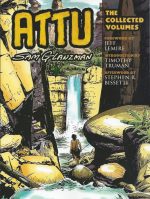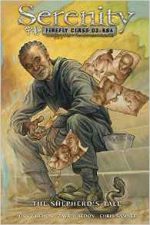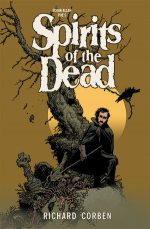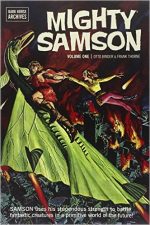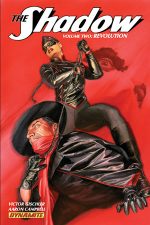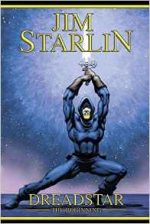 By Jim Starlin (Dynamite Entertainment)
By Jim Starlin (Dynamite Entertainment)
ISBN: 978-1-60690-119-9
The creative renaissance in comics during the 1980s resulted in some utterly wonderful strip sagas which shone briefly and brightly within what was still a largely niche industry before passing from view as the business and art form battled spiralling costs, declining readerships and the perverse and pervasive attitude in the wider world that comicbooks were the natural province of mutants, morons and farm animals (I’m paraphrasing).
Unlike today, way back then most grown-ups considered superheroes as adolescent power fantasies or idle wish-fulfilment for the uneducated or disenfranchised, so an entertainment industry which was perceived as largely made up of men in tights hitting each other got very little approval – or even notice – in the wider world of popular fiction.
All that changed with the advent of the comic book Direct Sales Market. With its more targeted approach to selling, specialist vendors in dedicated emporia had leeway to allow frustrated creators to cut loose and experiment with other genres – and even formats.
All the innovation back then led inescapably to today’s high-end, thoroughly respectable graphic novel market which, with suitable and fitting circularity, is now gathering and re-circulating many of the breakthrough tales from those times; not as poorly distributed serials and sequences, but in satisfyingly complete stand-alone books.
Marvel was the unassailable front-runner in purveying pamphlet fiction back then, outselling all its rivals and monopolising the lucrative licensed properties market (like Star Wars and Indiana Jones) which once been the preserve of the Whitman/Dell/Gold Key colossus. This added to a zeitgeist which proved that for open-minded readers, superheroes were not the only fruit…
As independently published titles hit an early peak, Marvel instigated its own creator-owned, rights-friendly fantasy periodical in response to the overwhelming success amongst older readers of Heavy Metal magazine. Lush, slick and lavish, HM had even brought a fresh, music-&-literature based audience to graphic narratives…
That response was Epic Illustrated: an anthological magazine offering stunning art and an anything-goes attitude – unhindered by the censorious Comics Code Authority – which saw everything from adaptations of Moorcock’s Elric and Harlan Ellison novellas to ‘The Last Galactus Story’, plus numerous stories which would become compelling forerunners of today’s graphic novel industry.
The first issue also discretely started a very gradual introduction to one of the era’s biggest Indie sensations: Vanth Dreadstar…
This collection gathers a number of stories originally culled from an assortment of different places. The saga started in Epic Illustrated (#1-9, 12 and 15, spanning Spring 1980 to December 1982), whilst tangentially diverting in 1981 to Eclipse Graphic Album Series #5 (The Price) and then 1982’s Marvel Graphic Novel #3: Dreadstar: all laying the groundwork for one of the most successful independently-owned comic book characters of the era, and one of the most long-lived…
This stellar hardback re-presents those tales in the original monochrome or painted full-colour, with writer/artist Starlin aided and abetted by letterer by Tom Orzechowski. For this edition the art has been remastered by Jerron Quality Color, Mike Kelleher and Digikiore Studios.
Already a big gun thanks to his run on Captain Marvel, the engendering of mad Titan Thanos and the reinvention of Adam Warlock, Starlin cemented his cosmic creator credentials and seeming preoccupation with death and nihilism through the grandiose saga Metamorphosis Odyssey.
Delivered in painted grey-tones, the serialised tale began with the introduction of mighty alien wizard ‘Aknaton’: savant of ancient and benevolent race the Osirosians. These masters of the cosmos were perturbed by the advent of rapacious barbarian species the Zygoteans who were slowly and inexorably conquering planets and eradicating all life in the Milky Way galaxy.
Aknaton’s people fought back on behalf of all creation, but knew that their resistance was numbered in mere millennia before the predators would win.
Unsettled by the prognostication, Aknaton set out on a desperate tour of the galaxy, planting life seeds weaving a web of possibility and even depositing an incredible sword of power in a last-ditch plan which would take a million years to complete…
The first seed flowered in the form of spiritually advanced intellectual monster ‘Za!’, whilst another blossomed into 15-year old ‘Juliet’, taken by Aknaton from Earth in 1980 just as the Zygoteans arrived to eradicate the rest of her species.
The mage’s last living puzzle component was butterfly winged psychic ‘Whis’par’ whose gifts and sensitivities easily divined the dark underpinnings of Aknaton’s ambitions…
During this chapter the artwork transitioned into full-painted colour, and by the time the wizard reached war-torn ice-world Byfrexia to recruit ‘Vanth’ the cosmic conflict was in full phantasmagorical flow. This emotionless resistance leader battling the Zygoteans was a man with incredible physical powers, bequeathed by a magic sword he had found: the very weapon Aknaton has planted eons previously…
‘The Meeting’ between Vanth and his notional maker was interrupted by Zygotean killers, affording the wizard opportunity to assess his handiwork in action. He quickly realised the hero was far more powerful than he had intended….
Nevertheless the quest moved on to a recently-razed paradise, but ‘Delloran Revisited’ was merely a step tin a search for an ultimate weapon so long lost, so well hidden that Aknaton had no clue to its current location…
Appraising his unique team of one final push, Aknaton enjoyed ‘Sunrise on Lartorez’ before absenting himself to meet God and discuss ‘Absolution’, after which a ‘Requiem’ sounded for life as the Zygoteans found them and lit the skies with ‘Nightfire’.
Forced into precipitate action, ‘Dreamsend’ turned into ‘Doomsday!’ as Aknaton’s plan finally came into play… with cataclysmic effect…
A million years later, an energy bubble bursts in another galaxy and sole survivors Aknaton and Vanth find themselves on a rural world not much different from any other. They still have business to settle and only one will walk away from the ‘Aftermath’ of what they’ve done…
With the illustration reverting to painted monochrome, The Price is set in that new Empirical Galaxy: one riven by an unending war between intergalactic robber barons the Monarchy and omnipresent mystico-political religious order the Instrumentality. Over 200 years these instinctive enemies have taken half a galaxy each and now battle to maintain a permanent stalemate. The economies of both factions depend on constant slaughter but no outright victory…
At the heart of that strained environment, rising Instrumentality bishop Syzygy Darklock is drawn by arcane forces and the diabolical plotting of terrorist mage Taurus Killgaren onto a path of inescapable doom and destruction.
It begins with the demonic assassination of Darklock’s brother; leading the outraged cleric on a path of damnation and revelation, gaining immense mystic power and wisdom but only at the cost of sacrificing everything he ever loved.
He also is forced to share Killgaren’s infallible vision of the fearful future and the role a man named Dreadstar will play in the fate of the universe…
After the huge success of ‘The Death of Captain Marvel’ (Marvel Graphic Novel #1), Starlin was eagerly welcomed back for the third release. Here he finally launched Dreadstar as a creator-owned property that would kickstart the Epic Comics line into life.
The full-colour painted story focused on Vanth the man, as the immortal Cold Warrior abandoned his sword and warlike ways, settling down to decades of farming on isolated agri-world Caldor with retired Instrumentality researcher Delilah.
Toiling beside the gentle gengineered cat-people operating the farm planet, Vanth found a kind of contentment, which was only slightly spoiled when a bizarre creature named Syzygy Darklock set up his tent in the mountain wilderness and began tempting the old soldier with tales of the outer world and veiled promises of great knowledge and understanding .
Vanth was with the savant when Monarchy ships found Delilah and the cat-people. In the wake of their casual atrocities he renounced his vow of peace and resolved to end the stupid, commercially expedient war his way…
The drama concludes with ‘Epilogue’: one last black-&-white tale first seen in Epic Illustrated #15, and designed as bridging introduction to the hero’s comic book debut. Vanth and his cat-man ally Oedi are trying to quietly get off Instrumentality mining colony the Rock, but Dreadstar is nigh-fatally distracted by a worker who is the very image of his dearly departed Delilah.
Before he can do anything really stupid however the mine roof caves in and threatens all his ambitious plans to bring peace and stability to the Empirical Galaxy…
Bold, bombastic and potently cathartic, this is no-nonsense space opera with the just the right amount of deep thought, comforting cynicism and welcoming pop philosophy added to flavour the action and spice up the celestial grandeur. Above all this is smart, trenchant, uncomplicated fun for grown-up space freaks and well worth a few moments of your time…
© 2010 James Starlin. All rights reserved. Dreadstar is a registered trademark of James Starlin, and the Dreadstar logo and all characters and content herein and the likenesses thereof are also trademarks of James Starlin unless otherwise expressly noted.

